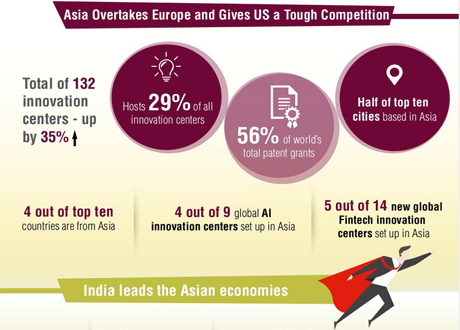Is Communication Sabotaging Your Ability to Innovate?
Avoid these four communications landmines as you navigate the stages of innovation.
Innovator Dilemma vs. Innovator Phenomena: The Theory of the Firm’s Phenomena
Established firms’ strategies remain characterized by the inability to master---some will say even comprehend---the economics of choosing. It is particularly surfacing unresolved relationships between [1] technical-technological, [2] economic and [3] social combinations taking place within established firms e.g. manufactured product.
Is Data Hindering Your Innovation Efforts? Five Data Missteps That Paralyze Innovation
Data can be a powerful enabler for innovation, but when used incorrectly, it can be a paralyzing force. It's a critical component in measuring and understanding the need for innovation—if you cannot measure something, you cannot improve it. Whether you collect data based on historical perspectives or through experiments, it can bring the insights needed for truly great innovations.
How the Innovation Principle Supplements and Balances the Precautionary Principle
The aim of the precautionary principle seems laudable: lacking scientific consensus, the burden of proof for an action or policy not being harmful to the public or to the environment lies on those taking that action. In practice, however, this principle has proven a deterrent for innovation - particularly within the EU. How can the innovation principle - that is, examining new policies or plans for a negative impact they have on innovation - help to supplement and balance out the precautionary principle?
Where to Start with Innovation? Begin by removing the Barriers
Surveys show that the large majority of senior executives see innovation as critical for their businesses but what if you want to make your organization more agile and innovative where should you start? You could launch a big initiative with grand statements, training classes and an ideas scheme but you tried all those last year and they fizzled out. It is better to begin with a brutally honest assessment of what is preventing innovation from happening today.
Five Ways Sustainable Innovation is Different from Normal Innovation
Today's innovation rules were forged in a world that paid little attention to sustainability, where profit was separate from this higher purpose. Yet the disruptive nature of sustainability must surely change the way we innovate too. We must continue to reinvent our innovation processes to ensure it is fit for a changing world, in the five ways highlighted here.
A Look Back at Three Innovations that Have Changed Our Lives
Nowadays, the words “innovation” and “creativity” get thrown around a lot in the business and academic world. But the road to making successful innovations is filled with challenges, opportunities taken or missed, and plenty strikes of luck. Often, people invent machines to face a recurrent problem. These inventions, in turn, spawn other inventions and innovation. These types of inventions have the most impact on society. Here’s looking at three inventions that have changed our lives forever.
Three Hurdles to Sustainable Innovation
Most people agree on the importance of sustainability in innovation, so why is it difficult to deliver? In this article, we’ll explore three hurdles to sustainable innovation: it’s often not considered by innovators themselves as they plan their projects; sustainability is not framed as an exciting and imaginative opportunity; and that sustainable innovation may not fit into a company’s ongoing processes.
The Engineering Behind Modern Superstructures
Human talent, drive and innovation can achieve incredible feats - and what more tangible example than modern superstructures? Let’s take a look at some of the drivers behind building bigger and better buildings worldwide, from improved materials, to cross-sector collaboration and beyond.
Are Corporate Innovation Centers The Last Hope for Companies Too Big To Fail?
Companies once deemed “too big to fail” are increasingly exposed to failure. The threat of disruption is everywhere. Startups are taking on the Goliaths in every market. Scores of malls across the United States are in collapse. Many household brand names are losing ground or even shutting completely. Regardless of industry, businesses face digital Darwinism, the evolution of technology and markets. Disruption is just a matter of when, where and why. To compete, executives must make tough decisions but more so, they must look to new horizons for new insight and direction. Whether companies thrive or cower in the face of digital Darwinism is a choice.
What Do Innovators Look Like?
Crowdsourced innovation is a tactic used more and more often by government organizations as well as enterprise corporations. This means that innovation teams need to add a new skill set to their resumé: communications.
Innovation Through Cross-Industry Learning: How is it Changing the World?
Cross industry learning, the transfer of technologies across industry boundaries, can revolutionize technology landscapes. We will illustrate the advantages of cross industry learning with a case study.
3 Advantages to Collaborating on Innovation as a Global Community
The list of problems that need to be solved is growing almost as fast as our solutions are. Some are concerned about the lack of food and water security, others worry about access to education and a whopping 45.2% of millennials think today’s most pressing problem is the destruction of natural resources. But with the proliferation of problems, organizations and enterprises are broadening their search for innovative solutions and many of them are looking to the crowd for ideas.
Rebuild Personas According to Your Next Product Innovation
Using personas in your design thinking framework is important, but are the results satisfying and clear? In this article, Product Innovation Manager Alex Igor Sanghikian discusses the Adjacent Possibilities framework for product management. By exclusively focusing on your persona’s one main need and trying hard to fulfill that need with your product, you can build the next feature with a more focused vision.
The Four Essential Steps Towards Open Innovation Success
Although ‘open innovation’ is the talk of the town in R&D circles, leveraging external sources of innovation remains challenging for most companies. In 2013, researchers Dr. Joel West (Keck Graduate, Institute of Applied Life Sciences) and Dr. Marcel Bogers (University of Southern Denmark) suggested a four-phase model for inbound innovation projects. They emphasized that open innovation needs to go further than just obtaining external ideas. Integration, commercialization and the interaction between the firm and its collaborators are just as important. This post explores the four essential steps towards open innovation success.
How Improvisation can Boost Innovation
If you have an innovative culture already in place (meaning you’re working with stuff like agile project management, design thinking, lean, etc.) perhaps it’s time you consider Applied Improvisation Training. If instead you are a static and uncommunicative company, Applied Improvisation may even work against your innovation efforts. Edoardo Binda Zane explains more.
Executing on Innovation – The Required Key Ingredients
Innovation: We all have seen the biggest, most successful companies talk about it and share their success stories. We have read about it in the latest business journals and magazines. We all want it in our organization but the right recipe with the right ingredients is often elusive. In this article we will share different views and discuss key ingredients required to create, execute, and innovate in your organization.
Involving Citizens in Government Product Development
The election of 2016 will certainly be one for the history books. Regardless of your political leanings, there was one sure thing to celebrate during this election cycle. The Innovate Your State Fix California Challenge—a crowdsourcing campaign aimed at promoting public participation in order to determine ways to improve government—had an initiative on the ballot in California!
How To Measure Event ROI (Return On Innovation)
Everyone knows about ROI, as in “return on investment.” But for evaluating the success of an experiential brand event or marketing campaign, businesses should take an equally close look at ROI, as in “return on innovation.”
Is Open Government the Same as Open Innovation?
For many years, companies were convinced of the competitive advantage of closed research and development. They jealously protected their intellectual property behind closed doors and dramatically revealed it to the public after years of development. This old model has since been replaced by open innovation.
Managing Risk and Shortcuts for Project Managers
Project managers are often dealing with loads of stress coming from all fronts, such as the pursuit of deadlines. Pressed by senior managers to deliver, project managers may find themselves resorting to risky shortcuts to make ends meet. Here are some ways to manage these risky shortcuts in project management.
How Innovation Equals Diversity: the Science and Promise of an Inclusive Workplace
Innovation may have a different meaning for every individual, but the true key to thinking outside the box lies in a diverse mindset. Allowing diversity into a business plan can be the secret to succeeding and achieving greatness. Don’t just take my word for it; evidence backs it up too.
The Value of Disruptive Innovation vs. the Value of Incremental Innovation
Most startups hope to disrupt their markets by delivering a novel idea or a more-suitable functionality—frequently at a lower price. Disruptive Innovation may be how your company arrives, but ultimately, as competition grows and your business and brand evolves, you will need incremental innovation to stay relevant.
The Dynamism in Chinese Ecosystems and Platforms
Today we have to “think China” when it comes to looking for the dynamism within Ecosystems and Platforms. They are leading, exploring and extending the thinking beyond our more limited ambitions in the West. It is the environmental conditions coming together or being explored and exploited that make China stand out in its dynamism in this area.
How the IoT can Change your Workplace
The IoT (or "Internet Of Things") is becoming a more popular topic of conversation these days. Many have already realized this with regard to individual use (say, through fitness trackers) or "smart homes." But the IoT can also have a huge effect on the workplace - here's how.
Innovation Fitness: Measuring It to Maximize It
To gauge the innovation capabilities of an enterprise, it is helpful to apply a systematic method for assessing the quality of, and the relationship between the various and distinct dimensions that drive all functions of the enterprise. As with a sports team, simply having talent does not ensure success. It is the quality of the team work which ultimately elevates or hinders the level of their play.
Top Diagramming Techniques for more Efficient Meetings
Do you ever find yourself stuck in a meeting that’s stalling? Does the agenda seem to accomplish no tangible outcomes? Perhaps you find yourself wondering what’s next after an important summit, or frustrated with the lack of direction after a meaningful brainstorm or discussion.
Why Top Executives Do Not Get Innovation – and What to Do About It
Many leaders of corporate innovation efforts struggle to get the support they need from executives higher up in the organization. Top executives can be skilled at talking the talk about innovation, especially in public venues, but frequently fail to walk the walk when it comes to making key choices that determine whether an innovation project will happen or die on the vine.













